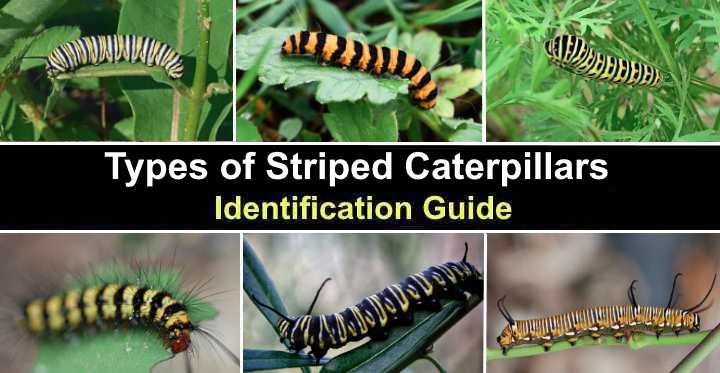Caterpillars, also called larvae, are the immature form of moths or butterflies. Striped caterpillars are considered to be among the most visually stunning caterpillars that can be found in gardens or in the wild. The appearance of these caterpillars varies in terms of the vividness of their colors, hairiness, number of spines, and size. Black, white, and yellow stripes with long horns are some of the most interesting features of striped caterpillars.
Caterpillars belong to the insect order Lepidoptera, and like all caterpillars, they undergo a process of development from eggs to larvae. Due to their habit of feeding on leaves of plants and trees, they have a huge appetite. During their growth phase, the larvae undergo several stages of development.
Furry caterpillars come in various colors depending on the genus of the caterpillar. Some striped caterpillars have green bodies with black and yellow stripes, while others have black or green bands. The black caterpillars with orange stripes and dots are some of the most intimidating-looking striped caterpillars.
Striped Caterpillar Identification
To identify striped caterpillars, it is important to take note of their color, the type of hairy covering they have, and the specific patterns they display. The stripes, spots, and “horns” on their bodies should also be observed in detail. It is important to note that the appearance of immature caterpillars and adult larvae can be quite different. The descriptions and identifying characteristics of striped caterpillars refer to their appearance as adult larvae before they enter the pupation stage.
Types of Striped Caterpillars (With Pictures and Names) – Identification Guide
Let’s study some of the most interesting striped caterpillar species in further depth. It is possible to differentiate between caterpillars based on their characteristics. You’ll also find out what shape of moth or butterfly these worm-like caterpillars morph into.
Monarch Butterfly Caterpillar

The Monarch caterpillar is a member of the Nymphalidae family and the Danaus genus, and is characterized by its yellow, white, and black stripes. As it grows, it feeds on milkweed. This caterpillar is also known as the “Common Tiger,” “Wanderer,” or “Milkweed” caterpillar.
The Monarch caterpillar has black, white, and yellow stripes that run around the segments of its body. As it matures, a pair of horns develop at the ends of its body. It is completely harmless and does not have any stingers. The white dots on the caterpillar’s prolegs are another identifying feature.
The caterpillar has stumpy “feet” on its middle segments and can grow up to 2 inches (5 cm) in length. These caterpillars are not dangerous or poisonous, and do not have any stinging spines, making them safe to handle.
Striped Caterpillar Identification
On milkweed plants it feeds on, a long, fat caterpillar with yellow, white, and black stripes stands out against the green foliage.
Black Swallowtail Caterpillar
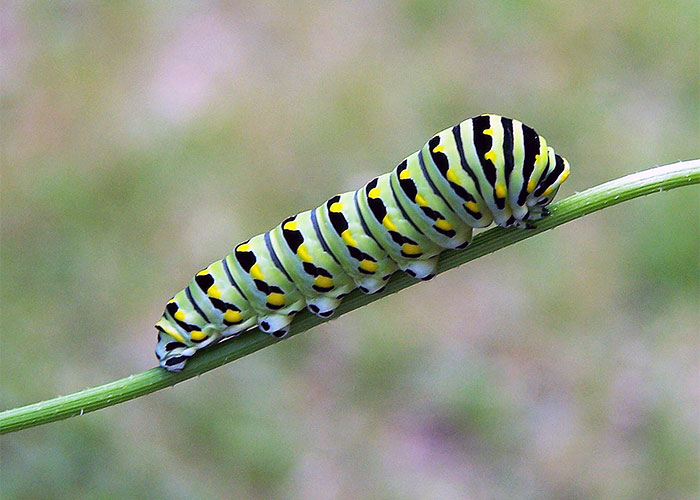
The Black Swallowtail butterfly caterpillar (Papilio polyxenes) is a member of the Papilionidae family of Lepidoptera that is green with black stripes and yellow markings on its body. It can be differentiated from the Monarch caterpillar by its green coloration instead of black. Each segment of the caterpillar’s body has a black stripe with yellow lines around it.
The four sets of green prolegs also have black dots. The osmeterium, a forked tongue-like structure, is one of the most noticeable features of this long, plump caterpillar. It emits a noxious odor from the osmeterium when predators approach it. Carrots, dill, parsley, and other garden herbs are the preferred foods of this species of green caterpillar.
Striped Caterpillar Identification
With its black wings and yellow, red, and blue patterns, this nasty green striped caterpillar completely transforms into the lovely Black Swallowtail.
Cinnabar Moth Caterpillar

The Cinnabar caterpillar (Tyria jacobaeae) is an orange and black striped caterpillar with spiky spines. From this caterpillar, a beautiful black and red cinnabar moth of the Erebidae family emerges. The caterpillars have a voracious appetite and can eat almost anything. They may even resort to cannibalism if no other food is available.
The striking black and orange caterpillar is easily identifiable due to its colorful segments. Long, thin, grayish hairs protrude from black bands that wrap around a yellow or orange body. Despite consuming large quantities of foliage, these caterpillars only grow to about 1.2 inches (3 cm) in length.
Striped Caterpillar Identification
Because of its black and yellow/orange striped patterns, ragwort is relatively easy to identify as a food source.
Queen Caterpillar

The Queen butterfly (Danaus gilippus) larva resembles the Monarch butterfly larva, having black and white stripes with yellow marks. The Queen caterpillar has a distinctive pattern of thick black stripes with yellow dots, making it easy to identify.
The pairs of long tentacles at each end and three-quarters down the body of this black and white caterpillar are also a distinguishing feature. The caterpillar’s head is black with white rings, and as it matures, it turns brown.
In addition to the black stripes, species with yellow, green, blue, and dark brown stripes have also been discovered. The Queen caterpillar is common in Texas, Florida, Mexico, and Central America.
Striped Caterpillar Identification
A obese caterpillar with a smooth exoskeleton and black and white stripes with yellow patches is both hairless and fat.
Striped Garden Caterpillar
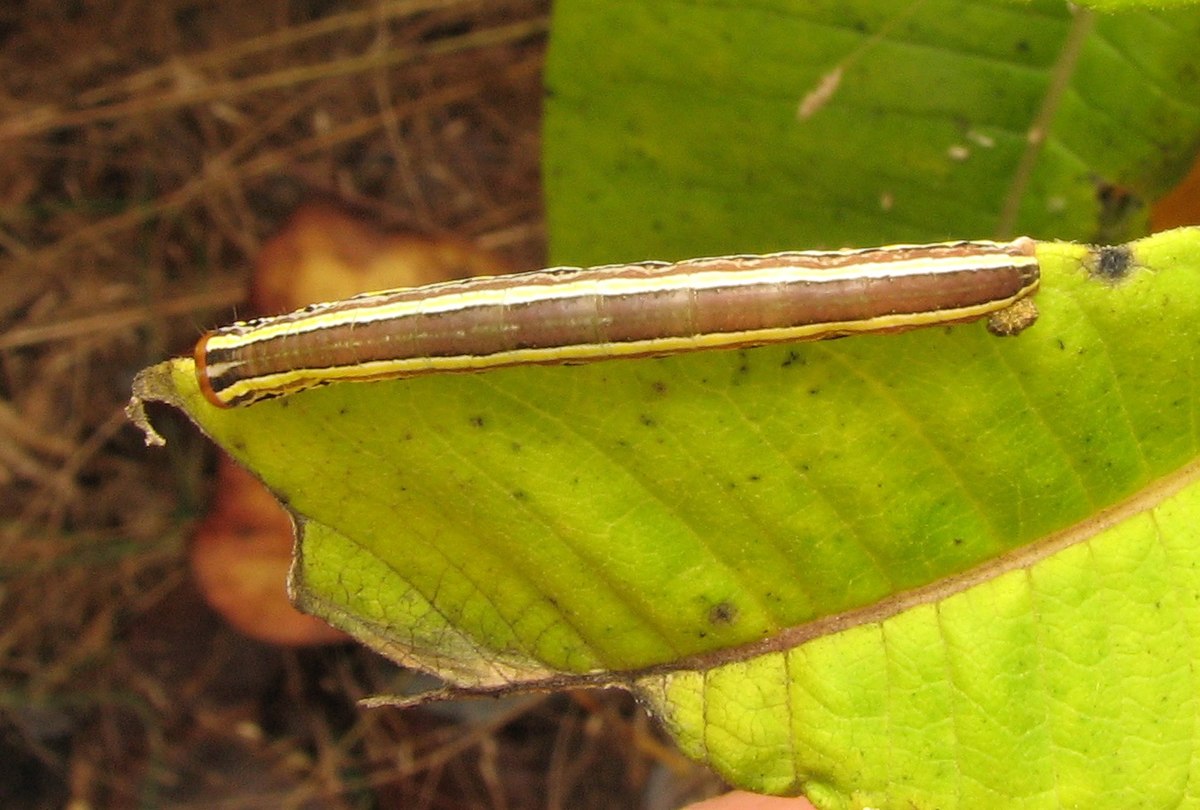
The Striped Garden caterpillar (Trichordestra legitima) is a common garden pest with a long brown body marked by light stripes. It has a worm-like appearance and can often be found feeding on herbaceous plants such as cherry, raspberry, mustard, milkweed, and violets. The caterpillar’s globular brown head is the only way to distinguish it from its long yellowish-white stripes.
Striped Caterpillar Identification
This caterpillar has bright stripes running the length of its sides that distinguishes it from other non-stinging and harmless caterpillars.
Orange Striped Oakworm Caterpillar

The Orange Striped Oakworm (Anisota senatoria) is a horned caterpillar that has a black body with orange stripes running the length of it. Despite its prickly appearance due to little spines that cover its body, this caterpillar is completely harmless and will not sting you. The Orange Striped Oakworm feeds on oak leaves and can grow up to 2.5 inches (5 cm) in length.
Some individuals of this caterpillar species have pink or yellow stripes. When they mature, beautiful yellow, pink, and orange-colored moths emerge from these caterpillars of the Saturniidae family.
Striped Caterpillar Identification
The striped orange caterpillar has a somewhat spiky back and has prominent black horns at the head end.
Giant Sphinx Caterpillar

The Giant Sphinx caterpillar is a huge striped caterpillar with black, yellow, and white stripes, and a crimson/orange head and tail. It can grow up to 6 inches (15 cm) long, making it one of the largest striped caterpillars you can find. The Giant Sphinx’s long, fat black body is covered in white bands, which make it easy to spot. There is a long spike protruding from the tail end, while the head and tail ends are brownish-orange or red in color.
Another feature of this striped caterpillar is its four sets of red-orange prolegs. As one would expect from a caterpillar of this size, it transforms into a big moth with a wingspan of over 1 foot (30 cm). The Giant Sphinx is a stinging caterpillar species, and its body is covered in fine urticating hairs that can cause skin irritation if handled. It can also bite if provoked.
Striped Caterpillar Identification
With yellowish bands around each segment, this huge kind of caterpillar is yellowish. This caterpillar is easy to identify because of its orange prolegs and head, as well as its huge size.
White-Lined Sphinx Caterpillar
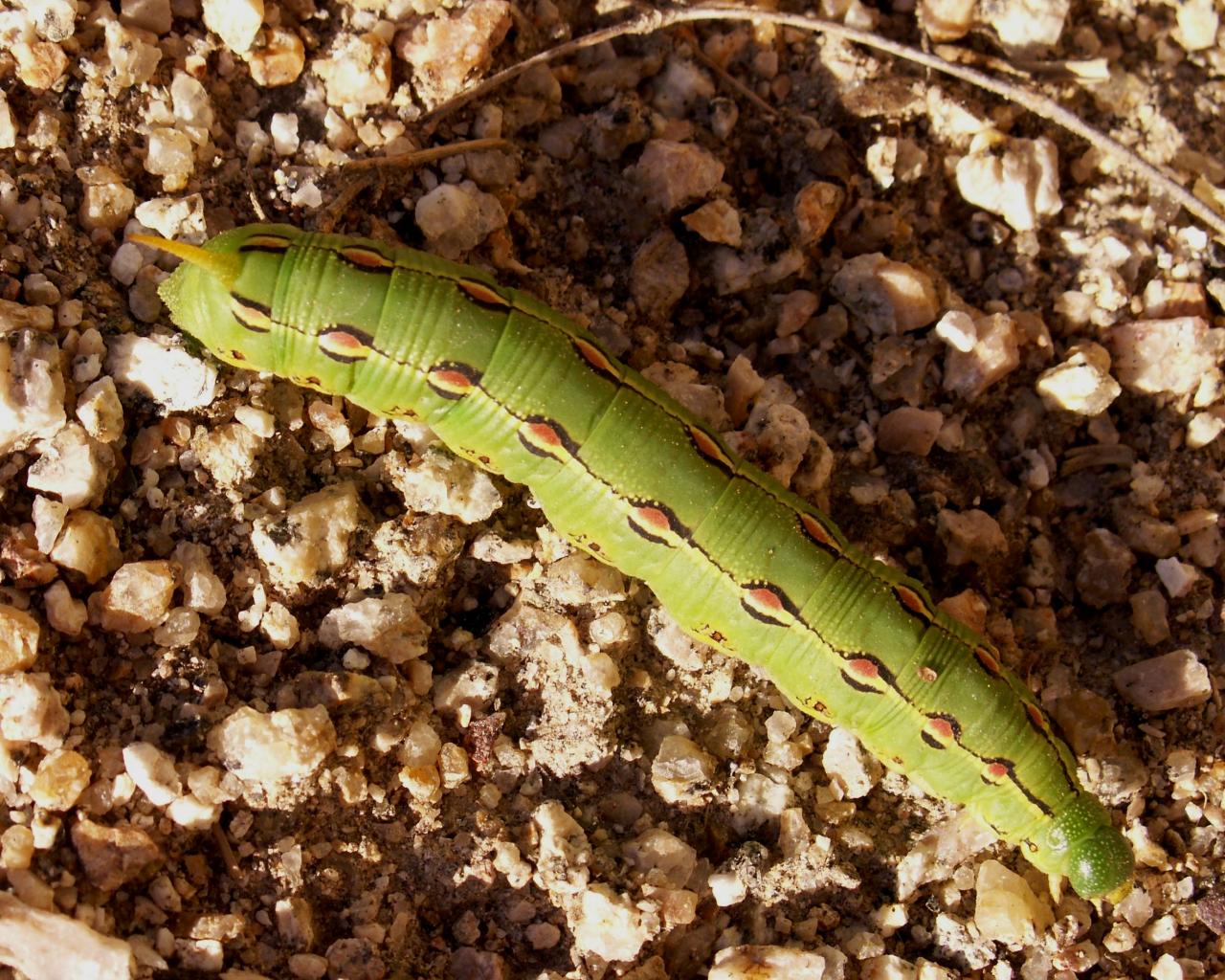
The White-lined Sphinx caterpillar (Hyles lineata) has a green body with two white lines that run along its sides. The caterpillar can have different color variations during its life cycle, depending on its Hyles genus. The White-lined Sphinx moth’s larvae have orange or black lines running down their bodies.
Some species have yellow bodies with black stripes, while others may have a lime-green body with black dots and yellow stripes, although this is rare. One of the caterpillar’s unique features is its black-tipped orange or yellow horn at the tail end, which looks like a sharp spike but is completely harmless.
Striped Caterpillar Identification
This sort of crawling insect is identified by stripes and dotted black patterns, as well as a solitary horn at its tail.
Zebra Caterpillar
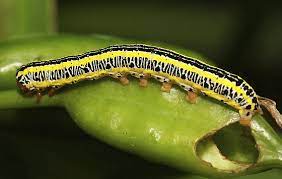
The Zebra Caterpillar (Melanchra picta) is recognizable by its reddish-brown head and black and white stripes that run across its segments. Its huge body is adorned with yellow stripes that run its length. Zebra caterpillars are commonly found feasting on cabbage leaves.
Initially, the larvae of these moths are white with black heads. As they grow, their colors become more vibrant. The body is striped with black and bright yellow stripes. Some species have a marbled effect due to the white-striped patterns. This leaf-munching caterpillar can be spotted by its reddish-brown head and light-colored legs.
Striped Caterpillar Identification
This caterpillar, which may reach 1.6 inches (4 cm) in length, has striking black, white, and yellow stripes.
Brown Hooded Owlet Striped Caterpillar
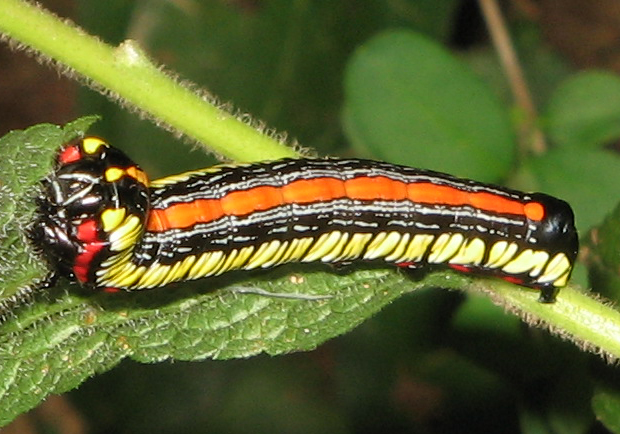
The Brown Hooded Owlet caterpillar (Cucullia convexipennis) is a black caterpillar with yellow stripes and red dots, similar to the Zebra moth caterpillars. Despite its similarities, there are a few ways to distinguish it from the Zebra caterpillar. One end of the caterpillar has a noticeable stump.
Its back is striped with a black stripe, with occasional white markings. Yellow stripes and a line of red dots run down the sides. The Brown Hooded Owlet caterpillar is frequently found feeding on asters and goldenrods. After pupating, the larvae transform into a large gray moth.
Striped Caterpillar Identification
Black, white, yellow, and red are the colors of this colorful caterpillar.
Azalea Caterpillar
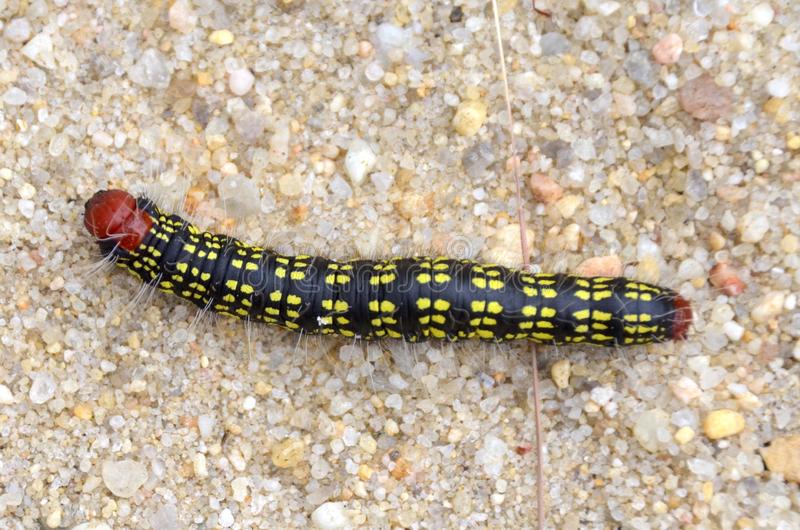
Azalea Caterpillars (Datana major) have a distinct round head and tail compared to other striped caterpillars. They often feed in clusters and can quickly devour entire azalea plants. These caterpillars have a light green and yellow/orange coloration, with thick black and thin green stripes running along their bodies.
Their heads are oval-shaped and rusty brown or orange in color, with spindly light hairs growing from them. Although not considered a dangerous insect, an infestation can cause significant damage to a garden. Azaleas, rhododendrons, apples, and blueberries are among the plants that these caterpillars commonly feed on.
Striped Caterpillar Identification
With a brown or orange globe-shaped head and a striped green and black body, these ravenous munching caterpillars.
Angle Shades Moth Caterpillar
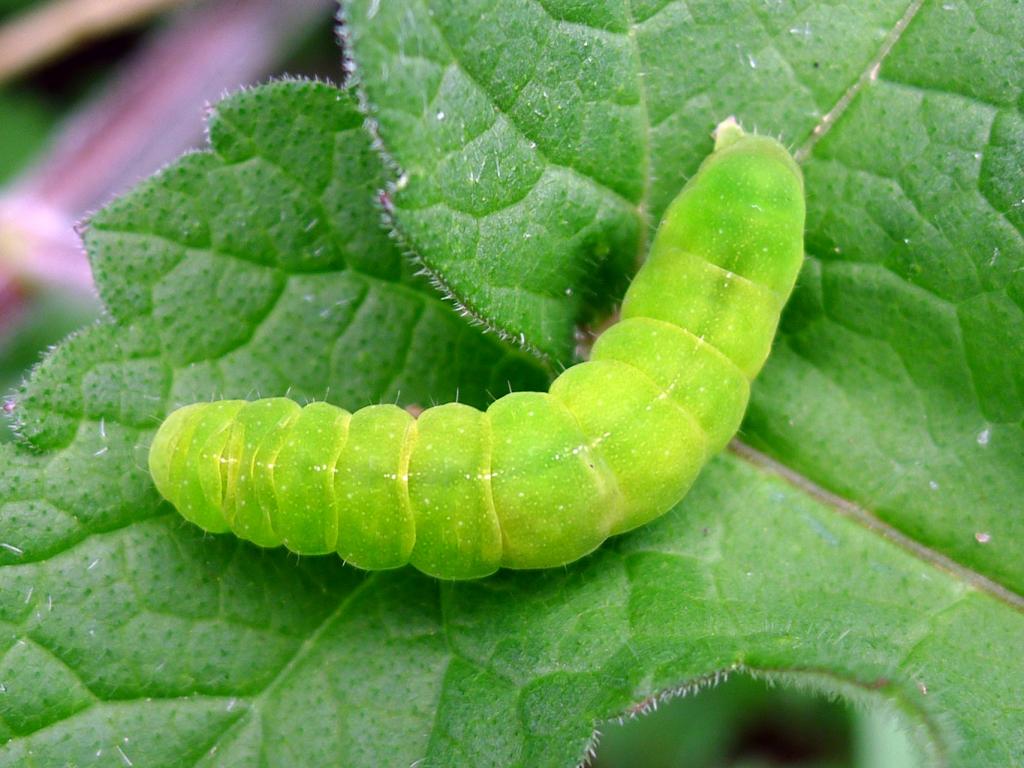
The Angle Shades caterpillar (Phlogophora meticulosa) is a bright green larva with a distinct pale stripe on each side. There are faint yellowish lines on the top that separate the segments, except for a long stripe on each side of its back. While green is the most typical color of this species, caterpillars with identical stripes may be pinkish-brown. The green color of this striped moth caterpillar blends in well with grass leaves, providing excellent camouflage.
Striped Caterpillar Identification
The lack of hairs and spikes, as well as a single white-yellow stripe along the sides, distinguish this caterpillar from other species.
American Painted Lady Caterpillar

The caterpillar of the American Painted Lady butterfly (Vanessa virginiensis) is a black, fuzzy caterpillar with stripes and a number of horn-like projections. The caterpillar has light-colored stripes running down its dark body, and it also has red and white dots. The light-colored bands on the caterpillar’s body are stripes that separate each segment. The spiky protrusions on the caterpillar’s body are also a notable feature. In addition to the white stripes, you can also see red and white dots.
Striped Caterpillar Identification
Look for white bands and jaggy-looking spines protruding from its back and sides.
Cross-Striped Cabbageworm

The Cross-Striped Cabbage Worm (Evergestis rimosalis) is a caterpillar with green body and yellow stripes on each side. These striped caterpillars can be easily identified and are known for their love for cabbages. These caterpillars belong to the Crambidae family of butterflies, which eventually transform into stunning butterflies.
These caterpillars have green body, prolegs, and head, and are often dotted with rows of green and black dots. Their yellow stripes run parallel to their sides, and they also have eye-like markings on their backs. Upon closer inspection, one may notice tiny spines sticking out of their back, but these caterpillars are harmless and do not sting.
The best way to protect crops from these pests is by handpicking them. They can be easily removed by hand, and their spines are not dangerous or painful.
Striped Caterpillar Identification
A light brown oval head with green body and patterned markings, as well as lateral stripes.
Angus Datana Moth Caterpillar

The Angus Datana caterpillar (Datana angusii) is a North American caterpillar with stripes of black, yellow, and white. It is a hairy caterpillar with long, thin spines covering its body, although it is not as fuzzy as a woolly bear caterpillar.
Striped Caterpillar Identification
This fuzzy caterpillar can be easily recognized by its black and white or yellow stripes that run along the length of its body. The caterpillar’s body is covered in clusters of thin, wispy white-grey hairs, giving it a fuzzy appearance. Its head is oval-shaped and black, which is another distinctive feature.
Gulf Fritillary Caterpillar
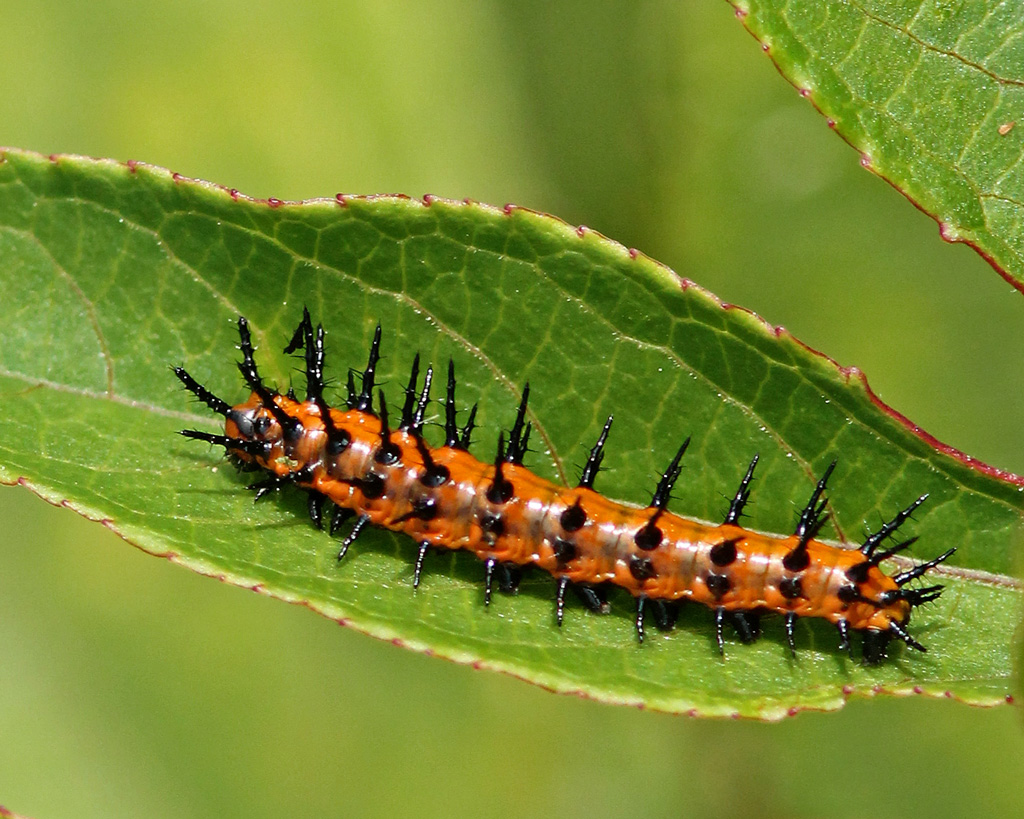
The Gulf Fritillary caterpillar is a fascinating larva species belonging to the Agraulis vanillae family. It has a brownish-gray body with yellow and white stripes that run down its sides. Its spiky spines make it look even more unusual. The Gulf Fritillary caterpillar is frequently found in Florida and Texas, among other places.
It has a dark brown or gray body with orange/yellow stripes on each side, as well as a single white stripe running down the length of its sides. The Passiflora plant is one of the Gulf Fritillary caterpillar’s favorite foods. This caterpillar eventually develops into a beautiful butterfly with striking orange wings.
Striped Caterpillar Identification
The lateral dark brown-gray, orange, and white stripes and jagged black spines on the body of the gulf fritillary caterpillar distinguish it easily.
Rosy Maple Caterpillar
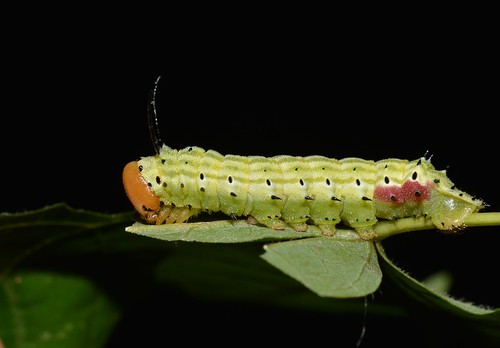
The Rosy Maple caterpillar (Dryocampa rubicunda) is a large caterpillar with a plump body and light green and white stripes with black dots. It has a striped pattern that runs down the length of its body, making it easy to identify. The sides of the body have wider green stripes, while the rear has wider white stripes with thin green stripes.
The caterpillar has a reddish head with two black horns, and the tail end has crimson markings. The small black dots on the sides of its body are another characteristic. There are also small black spiky protrusions on its rear end and prolegs.
These caterpillars feed on maple tree leaves and are often found in the eastern United States. Following their pupation stage, they emerge as some of North America’s most beautiful moths. The moths have pink and orange hues on their body and wings.
Striped Caterpillar Identification
The Rosy Maple caterpillar (Dryocampa rubicunda) can be recognized by its light green body with thin yellowish-green stripes running down it. The caterpillar has a round, tan-colored head with two large black spiky horns and rows of small, pointed projections.
Tobacco Hornworm Caterpillar (Manduca sexta)

The tobacco hornworm is a large green caterpillar with white diagonal stripes running down its sides. It has a plump lime-green body with a large pinkish horned tail, similar to the tomato hornworm.
A white-ringed black eyespot can also be seen on the side of each segment. This harmless green caterpillar can cause damage to plants, although it will not bite or harm humans. It is commonly found on tomato and tobacco crops.
The only difference between the tobacco and tomato hornworms (Manduca quinquemaculata) is the direction of the striped markings – the tomato hornworm has horizontal V-shaped markings, while the tobacco hornworm has slanted markings.
Striped Caterpillar Identification
Because of its enormous size, heavy downward-turned head, and sloping white stripes down its side, the tobacco hornworm is readily recognized.
Stinging Rose Caterpillar (Parasa indetermina)
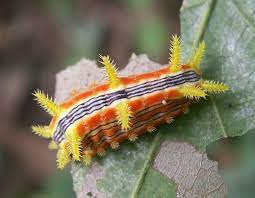
The venomous Stinging Rose caterpillar has a flattened body with bright yellow or orange color and a distinctive purple band running down its back. It has jagged spiny projections and clusters of poisonous spikes all over its body, which can deliver a painful sting to humans on contact.
This striped caterpillar is only about 1 inch (25 mm) in length, but its urticating fluid can cause a burning sensation that lasts for days. The Stinging Rose caterpillar can be found along the East Coast of the United States, from New York to Florida and east to Texas.
Striped Caterpillar Identification
Due to its brilliantly colored yellow or orange body with a purple stripe pattern down its back, the stinging rose caterpillar is easy to identify. Seven pairs of razor-sharp, uneven spines can also be found.
White-Marked Tussock Caterpillar (Orgyia leucostigma)

The white-marked tussock caterpillar has a distinctive appearance due to its black and yellow stripes, as well as the long, white hairs that cover its body. Four tufts of spiky cream-colored hairs on its back are another identifying feature of this caterpillar. The red dots on its back and the black pencil hairs on its hind end are also distinctive.
While the caterpillar is not a stinging variety, its long, barbed hairs can cause skin irritation. The white-marked tussock caterpillar can be found feeding on the foliage of deciduous and coniferous trees throughout North America. It can grow up to 1.3 inches (35 mm) in length, not including its wispy hairs.
Striped Caterpillar Identification
The white-marked tussock moth caterpillar can be recognized by its black and yellow striped body, as well as its four creamy white tufts that resemble toothbrushes. It also has red glands on its back for defense and long pencil-like hairs. Although it is not a stinging caterpillar, its hairs have barbed ends that can cause itchiness if they get into the skin. This caterpillar is commonly found in North America and is known to feed on the foliage of deciduous and coniferous trees.
Pink-Striped Oakworm Moth Caterpillar (Anisota virginiensis)

The pink-striped oakworm moth larva has two small antenna-like protrusions on its rounded, flat olive-colored head, and it is covered in small white dots. The striped caterpillar has four sets of black prolegs and fleshy projections on its body.
The caterpillar can grow up to 2 inches (50 mm) long and has a cylindrical body with dull brownish-yellow stripes. This leaf-feeding caterpillar is known to devour leaves from a variety of trees including maple, oak, birch, and hazel.
Striped Caterpillar Identification
The dark brownish and pink stripes on the pink-striped oakworm moth caterpillar are bordered by little white dots and run the length of its body.
Giant Woolly Bear Caterpillar (Hypercompe scribonia)

The big woolly bear caterpillar is a hairy, black caterpillar with reddish-brown stripes that is commonly referred to as a giant woolly bear. When threatened, the woolly bear curls into a defensive position, displaying its reddish stripes against its black, fuzzy body. Despite its furry appearance, the caterpillar’s spines are relatively sharp and can cause skin irritation when handled. As it grows up to 3 inches (75 mm), the black, fuzzy caterpillar develops into a hairy, red-striped creature.
The woolly bear caterpillar starts off with orange stripes and a thin covering of black hair when it’s young. It eventually becomes black with reddish-brown stripes. The giant black and red-striped caterpillar can be found on citrus trees, cabbage plants, sunflowers, and willow trees. Its toxicity makes it unpalatable to birds and other predators.
Striped Caterpillar Identification
A black caterpillar with black spines and vivid red bands around its segments, the giant woolly bear caterpillar is a black caterpillar.
Hackberry Emperor Caterpillar (Asterocampa celtis)

The hackberry emperor butterfly larva is easily recognizable due to its light green body with a distinctive yellow stripe running down its sides. The yellow stripe features a pattern of kidney-shaped green markings, while its rear end has a split tail that is forked.
This striped caterpillar can grow up to 1.5 inches (40 mm) in length and is known to blend in well with foliage, making it challenging to spot on trees. Its flattened translucent green head and small yellow raised dots on its body are additional distinguishing characteristics.
Striped Caterpillar Identification
The yellow band on the hackberry emperor caterpillar’s pale green body is what distinguishes it. It has a distinguishing characteristic in its split tail at the back.
Dragon-Headed Caterpillar (Polyura athamas)
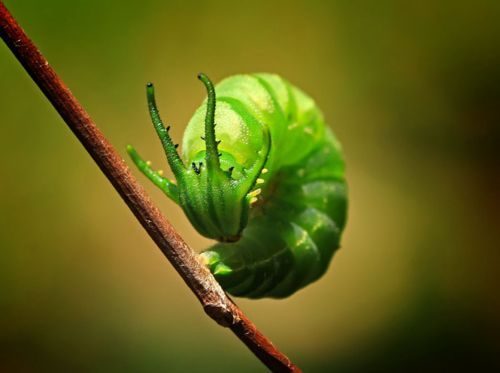
The dragon-headed caterpillar stands out with its four horn-like projections on its head and green or yellow stripes along its sides. The stripes can appear black or green depending on the caterpillar’s development stage. The flat, shield-shaped face with four spiny horns makes the dragon-headed caterpillar easy to identify.
Before it enters the pupation stage, the dragon-headed caterpillar can grow up to 1.18″ (30 mm) in length. When mature, the caterpillar’s back features three yellow V-shapes. This caterpillar is known for being a nocturnal feeder and can be found chewing through the leaves of various plant species.
Striped Caterpillar Identification
The dragon-headed caterpillar is characterized by four prominent fleshy projections around its flattened head. Its body is adorned with diagonal stripes in green or yellow hues, and a row of white spots can be seen along its side.
Banded Sphinx Caterpillar (Eumorpha fasciatus)

The banded sphinx moth larva is a unique caterpillar with a slug-like body that can grow up to 3 inches (76 mm) in length. They come in a variety of colors ranging from green to brown, with black dots on the sides. The caterpillar also has distinctive black crossing stripes and white diagonal bands, giving it a unique appearance.
Some of them are rusty brown with yellow stripes, while others turn bright red with yellow stripes when they are about to pupate. During the third instar, the caterpillar’s tail horn becomes quite noticeable.
Striped Caterpillar Identification
Green with yellow stripes, green with black stripes, or red with yellow stripes, the banded sphinx caterpillar is a tube-shaped striped caterpillar.
Honey Locust Moth Caterpillar (Syssphinx bicolor)

The honey locust moth larva has a distinctive appearance with green stripes, white speckles, and a red and white line running down its sides. It also has pointed silvery spines on each segment and two red horns at either end.
This green caterpillar with its colorful markings can grow up to 1.5 inches (38 mm) in length before pupation. During its second instar, the caterpillar has a white and black line down its back and several black spiny horned defenses.
Striped Caterpillar Identification
The honey locust moth caterpillar is identifiable by its green color, white and red stripe running down each side, and scattered white spots all over its body. The caterpillar also has two reddish horns on its head and tail end, which are unique features.
Orange-Barred Sulphur Caterpillar (Phoebis philea)

The orange-barred sulphur caterpillar is a green, yellow, and black striped caterpillar with small black bumps scattered on its body. It has a black head and yellow prolegs. As it grows, its segments become more yellow with black stripes. After pupation, this yellow-green striped caterpillar turns into a beautiful yellow butterfly found all across North America.
Striped Caterpillar Identification
The yellowish-green color, yellow lateral stripe, and heavy blue dots and bumps on the orange-barred sulphur caterpillar distinguish it from other caterpillars.
Box Tree Moth Caterpillar (Cydalima perspectalis)
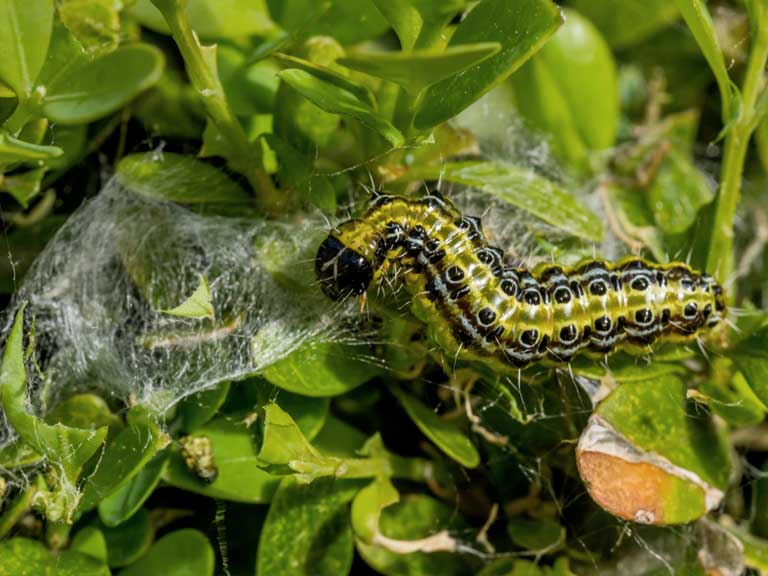
The box tree moth larva has a unique appearance with its black body and yellow stripes, and it is covered in small hairs. The green body of the caterpillar is marked with striped bands.
The caterpillar has a round black head, fine white spines, and two rows of black bumps on its back. The box tree moth caterpillar is typically around 1.5 inches (40 mm) long and is often found on boxwood shrubs. If not controlled, these green and black striped caterpillars can cause severe defoliation of the entire bush.
Striped Caterpillar Identification
The green and black striped tubular body of the box tree caterpillar features a few tiny fleshy bumps that produce a few small setae.
Hieroglyphic Moth Caterpillar (Diphthera festiva)
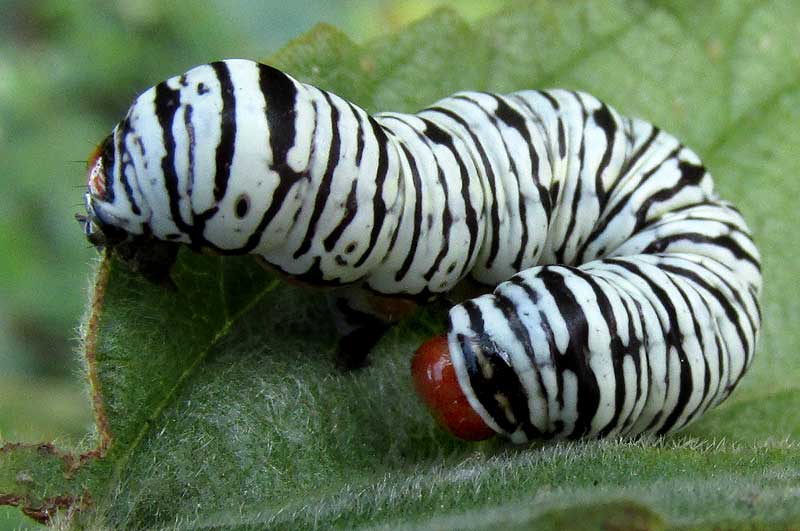
The hieroglyphic moth larva is a white caterpillar with distinctive black stripes and a reddish head, giving it a unique appearance. The striped caterpillar has bold zebra-like stripes in black and white along its body, with black dots covering its head. It grows up to 1.77 inches (45 mm) in length and is commonly found in Florida.
The hieroglyphic moth larva feeds on various crops, including sweet potato, soybean, and pecan, and can cause significant damage if not managed properly.
Striped Caterpillar Identification
The black-striped white caterpillar with zebra-like patterns is known as the hieroglyphic moth caterpillar. This species’ rounded orange-red head makes it easy to identify.
Pink-Spotted Hawkmoth Caterpillar (Agrius cingulata)

The pink-spotted hawkmoth larva is a dark-colored caterpillar with pinkish or orange-brown stripes. It has a wide pale cream-pink band along its sides with eyespot patterns, as well as two thin, darker orange-pink bands running down its back.
The caterpillar can grow up to 3.14″ (80 mm) in length and is easily identifiable due to its large size and distinctive coloration. It is known to feed on sweet potato plants and can cause significant damage if not managed properly.
Striped Caterpillar Identification
The smooth dark brown body of the pink-spotted hawkmoth caterpillar is speckled with pinkish or orange lines. These are triangular black specks with oval black patches.
Yellownecked caterpillar (Datana ministra)

The yellownecked caterpillar is a stunning black caterpillar with yellow stripes all over its hairy body. It has a distinctive orange or yellow collar-like structure that separates the black and yellow stripes. Additionally, the cylindrical caterpillar is covered in long, wispy hairs, which give it a fuzzy appearance.
The caterpillar grows up to 2″ (50 mm) in length and is easily recognized by its black and yellow stripes. It has a unique defensive posture where it rolls its head back into a “U” shape. Some photos also show the caterpillar with brown and yellow stripes.
Striped Caterpillar Identification
Because of the thin yellow stripe that runs from head to tail on its glossy black body, the yellownecked caterpillar is simple to identify.
Yellow-Tail Moth Caterpillar (Sphrageidus similis or Euproctis similis)
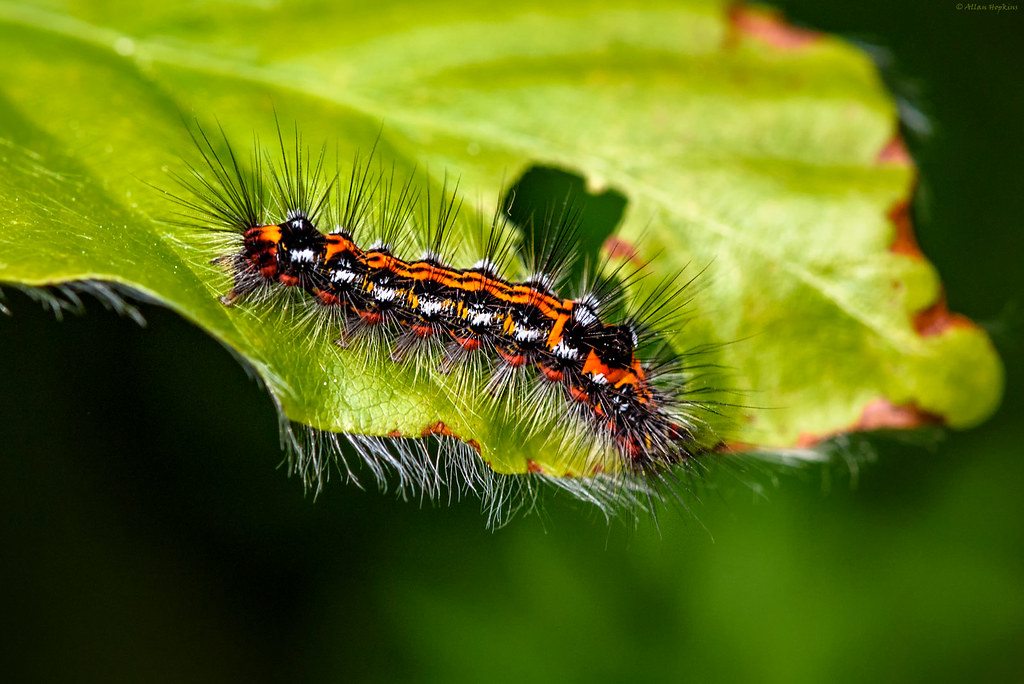
The yellow-tail moth larva can be easily identified by the orange lines on its back and white markings on its sides. A row of white spots is also visible on the sides of the black and orange caterpillar.
The bright reddish-orange band on its black body and the crimson bumps on its head are striking features. The caterpillar is about 1.2 inches (30 mm) long and has a distinctive orange stripe. It feeds on leaves of oak, birch, rowan, alder trees, and fruit trees.
Striped Caterpillar Identification
A hairy black caterpillar with a fiery orange band down its back and orange patterns on its head and tail, the yellow-tailed moth caterpillar is a hairy caterpillar.
Eight-Spotted Forester Caterpillar (Alypia octomaculata)
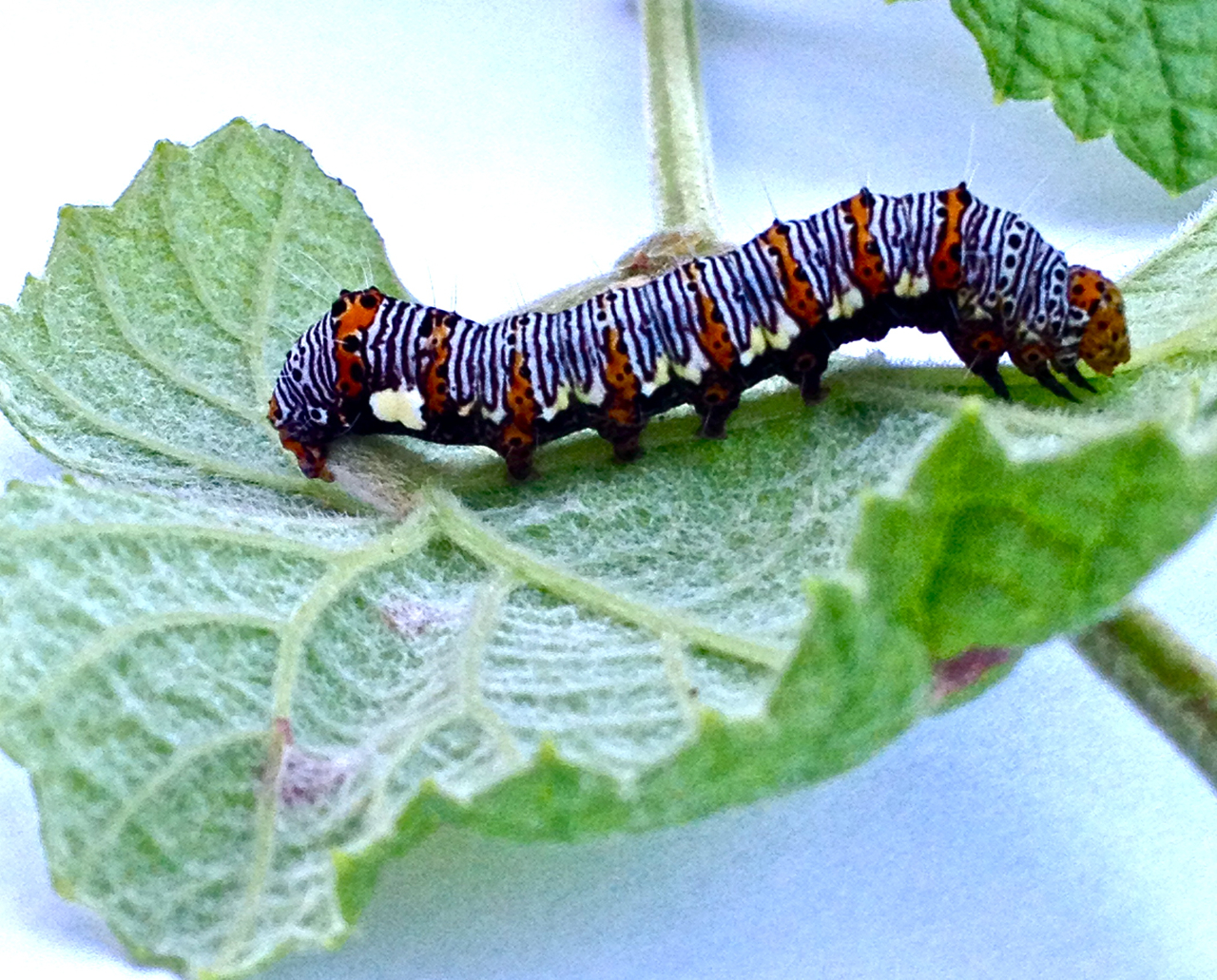
The orange eight-spotted forester caterpillar has a distinctive appearance with black hairy bumps running across its segments and stripes of black, white, and orange. In addition to the colorful stripes, it also has tiny black pointed fleshy bumps that give it a speckled look. Its body is covered in wispy white hairs, which can be seen protruding from it.
At full size, this orange and black striped caterpillar can reach a length of up to 1.30″ (33 mm), with black dots and black and white stripes. These caterpillars are often found feeding on Virginia creeper plants and can be commonly seen throughout eastern North America.
Striped Caterpillar Identification
The eight-spotted forester caterpillar’s orange, white, and black stripes, as well as black dots on its body, are all characteristics that distinguish it.
Catalpa Sphinx Caterpillar (Ceratomia catalpae)
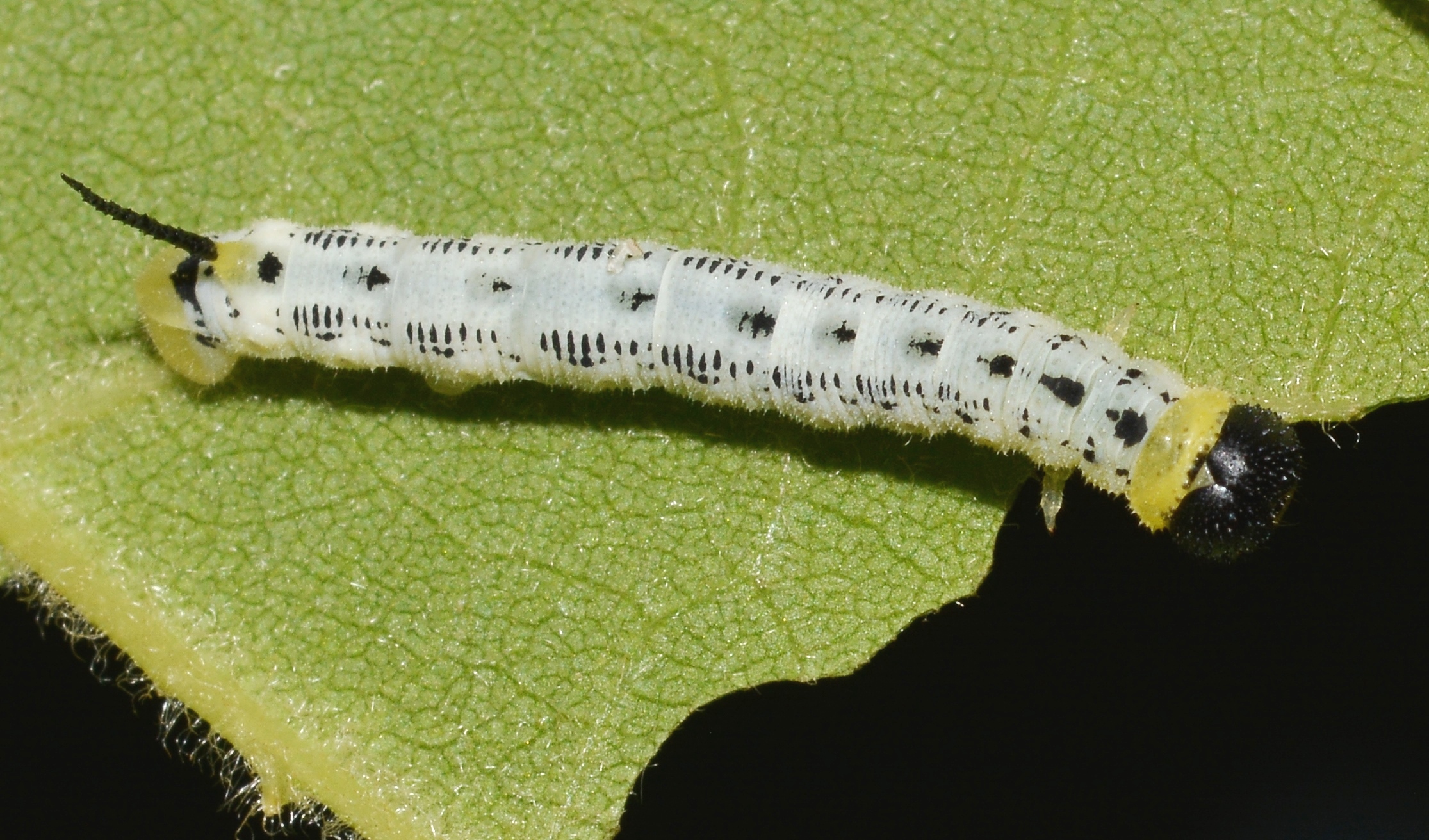
The mature catalpa sphinx larva is a stunning black caterpillar with distinctive neon yellow stripes on each side. The long, slender body of the worm-like caterpillar is also known as the Catawba worm and features a noticeable black horn-like tail. The yellow stripes on the black body are 2 inches (50 mm) long. The caterpillar of the catalpa sphinx undergoes color changes during different instars, and the immature caterpillars have a black stripe down their back and a greenish-yellow color.
Striped Caterpillar Identification
The bright yellow stripe running down each side of the jet-black body distinguishes the catalpa sphinx caterpillar.
Redhumped Caterpillar (Schizura concinna)
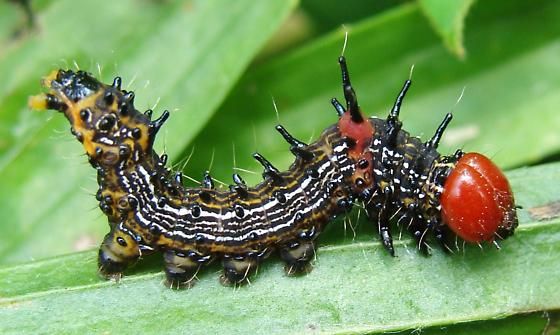
The larva of the redhumped moth is a captivating caterpillar with yellow, black, and white stripes that run the length of its body. It is easily identified by its bulbous red head, as well as short black fleshy spines and reddish growths behind its head. As the caterpillar matures, it tends to keep its rear end elevated, which is another distinguishing feature.
The caterpillar grows to be between 1 and 1.5 inches (25 to 38 mm) long and retains its yellow color with black and white stripes throughout its life stages. This black-striped yellow caterpillar can be found on woody plants throughout North America.
Striped Caterpillar Identification
The crimsonhumped caterpillar has a bright crimson thorax and reddish humps at the rear of its abdomen, making it simple to identify.
Old World Swallowtail Caterpillar (Papilio machaon)

The larvae of the Old World Swallowtail butterfly are green in color and have black stripes with red or orange spots that wrap around each segment of their body. The black stripes have a line of black dots running down their back, and their head has a few yellow spots that distinguish them from other green caterpillars.
They can grow up to 1.8 inches (45mm) long and have a defensive mechanism where they raise their body and emit a foul-smelling chemical to deter predators. Additionally, fleshy projections can grow from the rear of their head to intimidate predators.
Striped Caterpillar Identification
The green caterpillar with black and orange stripes on its segments is the classic world swallowtail caterpillar.
Common Buckeye Caterpillar (Junonia coenia)
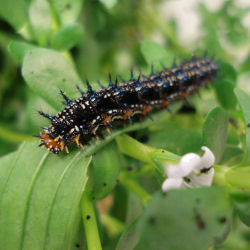
The common buckeye butterfly larva displays white or orange-brown stripes along its back and its coloration may vary depending on the species. The distinguishing features of this striped caterpillar include a reddish-orange head with black stripes, orangey-brown patches, and a brown underside.
At a length of 1.5 inches (40 mm), the spiny black-haired caterpillar displays a unique appearance. The common buckeye caterpillar’s physical appearance is not always the same, as some have black bodies with spiky branches and white spots while others have black and striped bodies. Common buckeye caterpillars are found in desert states like Arizona and can survive in hot, dry climates.
Striped caterpillar identification
Black caterpillars with black branched spines and orange-brown stripes are common buckeye caterpillars.
Frequently Asked Questions about Striped Caterpillars
Are striped caterpillars poisonous?
Typically, striped caterpillars are not harmful, and their stripes serve as a means of warning predators to stay away. However, it is the fuzzy caterpillars that can be dangerous, as they often have urticating hairs that can cause skin irritation, hives, and swelling if they come into contact with human skin. These hairs may contain toxins, making them more dangerous. It’s always best to avoid touching or handling fuzzy caterpillars to prevent any adverse reactions.
What do striped caterpillars feed on?
Striped caterpillars are known for feeding on the leaves of plants and trees. Some species, such as the Monarch caterpillar, have a specialized diet and only feed on specific plants, like milkweed. However, other striped caterpillars may feed on a variety of plant materials. In some cases, striped caterpillars may even eat other insects or caterpillars.
